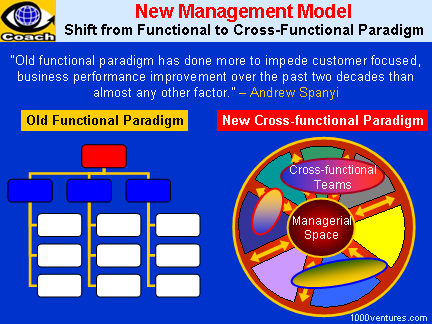|
Contents
1. Business Process Management: a Big
Picture
Balanced Business System
Corporate Growth Strategies
Business Process: Definition and
Characteristics
Extended Enterprise
Business Process Outsourcing (BPO)
2. Enterprise-wide Business Process
Management (EBPM)
Shift from Functional to
Cross-Functional Paradigm
The Payoffs of Process Approach to
Business
Process Thinking
EBPM Assessment Form
8 Essential Principles of EBPM
Cross-functional Management (CFM)
E-Business – Benefits and Opportunities
Customer Relationship Management (CRM)
Aligning Information Technology (IT)
and Business
Business Process Management System
(BPMS)
11 Traits of an IT Architect and a True
IT Leader
3. Continuous Improvement, Kaizen, Lean Production
Continuous Improvement Firm (CIF)
Japanese
Suggestion System: Goals and Benefits
Japanese-style Individual-based
Suggestion System
STRIDES: a Model for Solving Complex
Problems
Kaizen – Japanese Strategy for
Continuous Improvement
Kaizen Mindset
Kaizen: 7
Conditions for Successful Implementation
Quick and Easy Kaizen
Best Practices:
Practicing Kaizen at Fidelity Investments
Best Practices:
Employee Empowerment at Fidelity Investments
Kaizen and Radical Innovation
Lean Production – Doing More With Less
Lean Production: 7 Wastes To Be
Eliminated
Typical Benefits of Lean Production
An Overview of Lean Production
Components of Lean Production System
Just-In-Time (JIT) Manufacturing
Best
Practices: Toyota Production System (TPS)
Best
Practices: 7 Principles of Toyota Production System
(TPS)
Best
Practices: Canon Production System (CPS)
Best
Practices: Canon Production System (CPS) – Key
Structures
Case Study:
Lean Manufacturing at GSEP Ltd. (India)
Case Study:
Lean Manufacturing at Automotive Companies (USA)
10 Commandments of Lean Production and
Improvement
4.
Quality Management, Six Sigma
Computing the Cost of Quality
Total Quality Management (TQM)
Deming's 14 Point Plan for TQM
Kaizen and TQM
Areas Targeted by TQM in Japan
Japanese TQM Model
Best
Practices: 14 Slogans for TQM at Pentel. Japan
Lessons
from Jack Welch:
Live Quality
8 Rules for Managing Quality
Six Sigma: Benefits of Reaching Higher
Sigma Levels
Case Study:
Impact of Six Sigma Implementation at GE
Case Study:
Making the Six Sigma Process Work at GE
Integrating Six Sigma With Business
Process Management
Integrated Environmental and Quality
Management System (EQMS)
5. Process Innovation, Innovation
Process
Managing Operations vs. Managing
Innovation
The Tao of Business Process Innovation
Best
Practices:
Process Improvement at Fidelity
Investments
Innovation Process: Traditional and
Flexible Model
Case Study:
Attributes of Effective Innovation in Silicon Valley
The Jazz of Innovation
|

Transforming the
Traditional Functional Mindset
Excerpts from
BPM
- Approaches & Best Practices
by Andrew Spanyi
In far too many organizations, senior
management's traditional functional mindset represents one of the
most significant barriers to change. Indeed, there is reason to
believe that the traditional
functional paradigm has done more to impede customer focused,
business performance improvement over the past two decades than
almost any other factor.
This way of thinking stands in the way
of executives understanding and improving the flow of
cross-functional activities which create enduring value for
customers and shareholders. It promotes the type of thinking that
impedes the effective deployment of enabling information technology.
It promotes also 'silo behavior' and turf protection, and an undue
pre-occupation with organization structure. This mindset contributes
to the mistaken belief that if it was somehow possible to properly
define the boxes on the organizational chart, and fill in the names
of the "right" people in the key boxes - then the organization's
performance will automatically improve. Yet, little is further from
the truth. Further, it encourages a distorted view of performance
measurement and executive rewards, shifting focus away from
meaningful measures such as the timeliness and quality of services
provided to customers, and towards less significant measures around
functional departmental performance.
It reinforces a task focus and
traditional command and control behavior, where questions such as
'What is the scope of my responsibility?' and 'Who are the key
subordinates who can help me look good?' are foremost and top of
mind. Moreover, traditional functional thinking has also led to
outdated management practices in the areas of goal setting and
problem solving and it stifles innovation. So what to do? How can
you transform the traditional functional mindset such that your
organization is designed to make it easy for customers to do
business with the company and easier for employees to better serve
the company's customers?
An effective way of transforming the
traditional functional mindset is to embrace enterprise business
process thinking and install enterprise business process management
(EBPM) practices. What does this involve? Frankly, it requires a lot
of very hard work, and concepts which will make some of your
executives very, very uncomfortable. Why do it? Simply because the
benefits of making this mental model transition are significant.
|